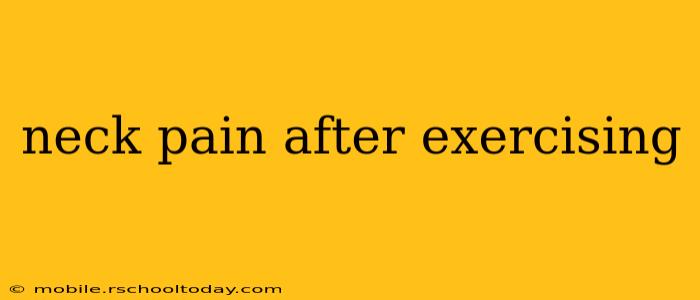Neck pain after exercising is a surprisingly common complaint, affecting athletes and fitness enthusiasts alike. While a little post-workout soreness is normal, persistent or severe neck pain warrants attention. This comprehensive guide explores the causes, prevention strategies, and effective treatment options for neck pain following exercise.
Common Causes of Neck Pain After Exercise
Several factors can contribute to neck pain after a workout. Understanding these causes is crucial for effective prevention and management.
1. Poor Posture and Form:
- The Culprit: Incorrect posture during exercise, particularly strength training exercises like squats, deadlifts, or overhead presses, can strain neck muscles. Failing to maintain a neutral spine or engaging in jerky movements puts undue pressure on the cervical spine.
- Example: Looking down at your phone while resting between sets compounds the problem, further stressing already fatigued muscles.
2. Muscle Strain or Sprain:
- The Culprit: Overexertion, improper form, or insufficient warm-up can lead to muscle strains or sprains in the neck. This is especially true for exercises that involve repetitive neck movements or significant weightlifting.
- Example: Rapid head rotations during boxing or poorly executed weight training routines can easily trigger muscle injuries.
3. Dehydration:
- The Culprit: Dehydration can reduce muscle elasticity and increase the risk of injury. Muscles become tighter and less flexible, making them more susceptible to strain during exercise.
- Example: Failing to replenish fluids lost through sweat during intense exercise increases the likelihood of muscle stiffness and subsequent neck pain.
4. Underlying Medical Conditions:
- The Culprit: Pre-existing conditions like arthritis, degenerative disc disease, or whiplash can exacerbate neck pain following exercise. These conditions often make the neck more vulnerable to injury.
- Example: Individuals with existing cervical spine issues might experience heightened discomfort after even moderate physical activity.
5. Repetitive Stress Injuries:
- The Culprit: Repeated movements, particularly those involving awkward neck positions, can lead to repetitive strain injuries (RSI). These are common in sports like swimming, cycling, or rowing where the head is held in a fixed position for extended periods.
- Example: Maintaining a forward head posture while cycling can put significant stress on the neck muscles.
Preventing Neck Pain After Exercise
Prevention is key to avoiding post-workout neck pain. Incorporate these strategies into your fitness routine:
1. Proper Warm-up:
- The Solution: A thorough warm-up, including gentle neck stretches and rotations, prepares your muscles for exercise and reduces the risk of injury.
- Example: Begin with 5-10 minutes of light cardio followed by neck stretches like chin tucks and gentle side bends.
2. Correct Exercise Form:
- The Solution: Focus on maintaining proper posture and form throughout your workout. If unsure about correct technique, consult a qualified fitness professional or physical therapist.
- Example: Video recording your workouts can help you identify and correct any postural flaws.
3. Gradual Progression:
- The Solution: Avoid sudden increases in intensity or duration of exercise. Gradually increase the weight, repetitions, or intensity to allow your body to adapt.
- Example: Increase the weight you lift by only 5-10% each week to prevent overtraining.
4. Hydration:
- The Solution: Stay adequately hydrated before, during, and after your workout. Dehydration can increase muscle stiffness and vulnerability to injury.
- Example: Drink plenty of water throughout the day, particularly before, during and after exercise.
5. Cool-down and Stretching:
- The Solution: Incorporate a cool-down period with gentle stretching after each workout to reduce muscle tension and promote recovery.
- Example: Perform neck stretches like gentle rotations and side bends, holding each stretch for 20-30 seconds.
Treating Neck Pain After Exercise
If you experience neck pain after exercising, several treatment options can provide relief:
1. Rest and Ice:
- The Solution: Allow your neck to rest and apply ice packs for 15-20 minutes at a time, several times a day, to reduce inflammation.
- Example: Avoid strenuous activity and prioritize rest to allow your muscles to recover.
2. Over-the-Counter Pain Relievers:
- The Solution: Nonsteroidal anti-inflammatory drugs (NSAIDs) like ibuprofen or naproxen can help reduce pain and inflammation.
- Example: Always follow the recommended dosage instructions on the packaging.
3. Physical Therapy:
- The Solution: A physical therapist can assess your condition, develop a personalized treatment plan, and teach you exercises to strengthen and stretch your neck muscles.
- Example: They may use techniques like manual therapy, ultrasound, or electrical stimulation to alleviate pain and improve mobility.
4. Medical Attention:
- The Solution: If your neck pain is severe, persistent, or accompanied by other symptoms (e.g., numbness, tingling, weakness), seek medical attention from your doctor or a specialist.
- Example: They can diagnose the underlying cause of your pain and recommend appropriate treatment.
Disclaimer: This information is for general knowledge and does not constitute medical advice. Always consult with a healthcare professional for diagnosis and treatment of any medical condition.
